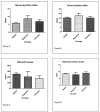Immune biomarker panel monitoring utilizing IDO enzyme activity and CD4 ATP levels: prediction of acute rejection vs. viral replication events
- PMID: 21492353
- PMCID: PMC3078420
- DOI: 10.1111/j.1399-3046.2011.01485.x
Immune biomarker panel monitoring utilizing IDO enzyme activity and CD4 ATP levels: prediction of acute rejection vs. viral replication events
Abstract
Infections have become as important an event as acute rejection posttransplant for long-term allograft survival. Less invasive biomarkers tested so far predict risk for one event or the other, not both. We prospectively tested blood and urine monthly for 12 months posttransplant from children receiving a kidney transplant. The IDO enzyme pathway was assessed by MS assays using the ratio of product l-kyn to substrate trp. Kyn/trp ratios and blood CD4 T-cell ATP levels were correlated with acute rejection or major infection events or stable group (no events) in the next 30 days. The 25 subjects experienced six discrete episodes of acute rejection in five subjects and 16 discrete events of major infection in 14 subjects (seven BK viruria, six cytomegaloviremia, one EB and cytomegaloviremia, and two transplant pyelonephritis). Mean serum kyn/trp ratios were significantly elevated in the group that experienced acute rejection (p = 0.02). Within-subject analyses revealed that over time, urine kyn/trp ratios showed an increase (p = 0.01) and blood CD4-ATP levels showed a decrease (p = 0.007) prior to a major infection event. These pilot results suggest that a panel of biomarkers together can predict over- or under-immunosuppression, but need independent validation.
© 2011 John Wiley & Sons A/S.
Figures

Similar articles
-
Verification of association of elevated serum IDO enzyme activity with acute rejection and low CD4-ATP levels with infection.Transplantation. 2013 Sep;96(6):567-72. doi: 10.1097/TP.0b013e31829c7cec. Transplantation. 2013. PMID: 23823655 Free PMC article.
-
Stable pediatric kidney transplant recipients run higher urine indoleamine 2, 3 dioxygenase (IDO) levels than healthy children.Pediatr Transplant. 2014 May;18(3):254-7. doi: 10.1111/petr.12232. Epub 2014 Feb 1. Pediatr Transplant. 2014. PMID: 24483723 Free PMC article.
-
Kynurenine Pathway after Kidney Transplantation: Friend or Foe?Int J Mol Sci. 2024 Sep 14;25(18):9940. doi: 10.3390/ijms25189940. Int J Mol Sci. 2024. PMID: 39337426 Free PMC article. Review.
-
Non-invasive monitoring of kidney allograft rejection through IDO metabolism evaluation.Kidney Int. 2007 Jan;71(1):60-7. doi: 10.1038/sj.ki.5002023. Epub 2006 Nov 15. Kidney Int. 2007. PMID: 17136028
-
Immune monitoring in renal transplantation: The search for biomarkers.Eur J Immunol. 2016 Dec;46(12):2695-2704. doi: 10.1002/eji.201545963. Eur J Immunol. 2016. PMID: 27861809 Review.
Cited by
-
Verification of association of elevated serum IDO enzyme activity with acute rejection and low CD4-ATP levels with infection.Transplantation. 2013 Sep;96(6):567-72. doi: 10.1097/TP.0b013e31829c7cec. Transplantation. 2013. PMID: 23823655 Free PMC article.
-
Stable pediatric kidney transplant recipients run higher urine indoleamine 2, 3 dioxygenase (IDO) levels than healthy children.Pediatr Transplant. 2014 May;18(3):254-7. doi: 10.1111/petr.12232. Epub 2014 Feb 1. Pediatr Transplant. 2014. PMID: 24483723 Free PMC article.
-
Kynurenine Pathway after Kidney Transplantation: Friend or Foe?Int J Mol Sci. 2024 Sep 14;25(18):9940. doi: 10.3390/ijms25189940. Int J Mol Sci. 2024. PMID: 39337426 Free PMC article. Review.
-
Indoleamine 2,3-dioxygenase activity and clinical outcome following induction chemotherapy and concurrent chemoradiation in Stage III non-small cell lung cancer.Oncoimmunology. 2013 Mar 1;2(3):e23428. doi: 10.4161/onci.23428. Oncoimmunology. 2013. PMID: 23802083 Free PMC article.
References
-
- Dharnidharka VR, Caillard S, Agodoa LY, Abbott KC. Infection Frequency and Profile in Different Age Groups of Kidney Transplant Recipients. Transplantation. 2006 Jun 27;81(12):1662–7. - PubMed
-
- Dharnidharka VR, Stablein DM, Harmon WE. Post-transplant infections now exceed acute rejection as cause for hospitalization: a report of the NAPRTCS. Am J Transplant. 2004 Mar;4(3):384–9. - PubMed
-
- Muthukumar T, Dadhania D, Ding R, Snopkowski C, Naqvi R, Lee JB, et al. Messenger RNA for FOXP3 in the urine of renal-allograft recipients. N Engl J Med. 2005 Dec 1;353(22):2342–51. - PubMed
-
- Peng W, Chen J, Jiang Y, Wu J, Shou Z, He Q, et al. Urinary fractalkine is a marker of acute rejection. Kidney Int. 2008 Dec;74(11):1454–60. - PubMed
Publication types
MeSH terms
Substances
Grants and funding
LinkOut - more resources
Full Text Sources
Medical
Research Materials

